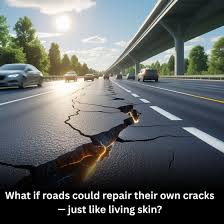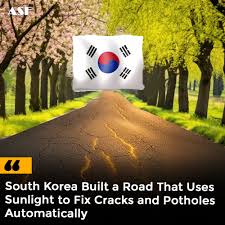Table of Contents
Introduction to the Self-Healing Road
Think of a self-healing road. And to think, it seems like a scene in an invasion sci-fi film. In South Korea, self-healing roads are the newest thing that came out as a futuristic reality. The new routes will repair the cracks and damages through the most modern technologies that utilize sunlight. It is not only an engineering masterpiece; it is an engineering and infrastructure maintenance vision of the future. With the world confronted by aging road systems and sky-high maintenance rates, the self-healing road technology in South Korea might turn our understanding about sustainable pavement and roadways all upside-down. And now, let us explore more on how this game-changing development takes place and what it means to our world.
How Does It Work?

The auto-repairing system in South Korea works with a tremendous fusion of superior materials and fashionable technology. It is made of special polymer reacting to heat, especially sunlight. This material gets softened when the temperature increases.
When it is heated up, small cracks begin to seal together naturally. The procedure is very amazing; minor repairs do not require any human involvement. This feature simplifies and increases the efficiency of maintenance.
Moreover, intelligent sensors will be able to measure the situation on the road in real-time. They identify the problems such as stress points or bigger damages before these problems become big. The combination of these features only increases the lifespan of the self-healing road and makes driving on the road safe.
This smart infrastructure is a high jump in the civil engineering solutions. Its self-healing capabilities decrease its dependence on conventional techniques which in most instances are expensive and time consuming.
Benefits of the Self-Healing Road
A self-healing road is a road in South Korea that has many benefits that can change the maintenance of infrastructure. The decrease of repairing expenses is one of the greatest advantages. City roads cost less in terms of frequent repair costs and labor since the technology can heal itself.
Improved safety is another major strength. Accidents frequently occur because of cracks and potholes, particularly, in the densely traveled places. The drivers and the pedestrians are kept at minimal risks thanks to a self-repairing surface.
Besides, the technology supports sustainability. Such roads reduce over-dependence on conventional asphalt whose ecological imprint is considerable by using materials capable of regeneration under sunlight.
In addition, the durability of such novel surfaces becomes much higher. It is a long life leading to lesser investments made on renewal projects.
Well maintained roads are aesthetically pleasing. Smooth surfaces enhance travel as well as pride of community mainly because of its visual attractiveness in terms of infrastructure.
Impact on the Environment and Infrastructure Maintenance Costs
The South Korean self-healing road is an improvement in the management of the infrastructure business. This advanced technology is self-repairing as well as less destructive to the environment.
The conventional road maintenance can be a very resource-intensive process that applies both resources: materials and labour. Having self repairing, the required frequent repair sessions is reduced drastically. And this efficiency results in having fewer carbon-based emissions during the construction activities.
Besides, removing regular resurfacing will reduce the interference with nearby nature. Presence of fewer machines at the site translates to less disturbance on habitat and noise pollution.
Financially, the savings in the long term are huge. Cities will be able to deploy money that has been committed to continual maintenance to other urgent community requests or sustainability purposes.
It promotes the investments in the creation of more eco-friendly technologies and increases the general condition of the urban environment to be less vulnerable to traffic and weather conditions.
Potential for Global Implementation
There is a huge opportunity to implement the self-healing road in South Korea to the rest of the world. This technology can be of great help to countries that have been riddled with extreme weather conditions. Think of roads that will not lose their bounty in winter or during a heat wave.
One can experience positive changes in urban areas with heavy traffic as well. The maintenance time is less and, therefore, more convenient to drivers and pedestrians.
Moreover, third world countries might be attracted by the technology because it will be cheaper in the long-term. The upfront investment may end up saving a lot of money in repair in future.
The cooperation of nations might help to provide even rapid growth of materials science and engineering providing even more creative ways to deal with mechanical problems. By pursuing such technologies in every country of the world, we would open a new way to a smarter infrastructure system, turning our concept of the roadways upside down.
Criticisms and Limitations
Though the self-healing road in South Korea is introducing revolutionary technology, it does not come short of criticisms. The first question is the long-term functionality of this new media. Its critics doubt that it will be able to endure rainstorms and clogged roads during long time horizons.
The other restraint is the cost of implementation. Importation of the modern materials and technology involved may be too expensive to allow many municipalities to implement at a wide scale.
Moreover, the maintenance procedures should also need to be adjusted to these new roads. The conventional practices in repairing may no longer be an option and so the present strategies of infrastructure need to be thought over almost completely.
An environmental impact also raises eyebrows. Though the product may be used to minimize the amount of waste, producing the material may contain eco-unfriendly materials.
Society is yet to accept what is perceived as unfamiliarity to put this untested solution to its daily life.
Conclusion: The Future of Infrastructure Technology
A very good instance of using technology to revolutionize any kind of infrastructure is the self-healing road in South Korea. Having the cracked routes repaired under the effect of sunlight, this will not only increase the life of the road longer but also will result in a huge piece of savings of money in the process of repairs. With cities across the globe struggling with old infrastructure and tight budgets, such technologies may show the way to more intelligent urban planning.
In addition, it is difficult not to notice the environmental advantages. A decreased demand on repairs leads to less resources being used and less wastes produced. Consider a world in which our roads work towards maintaining themselves but at the same time reduce loads on our environmental impact.
In spite of some obstacles that need to be overcome (like the initial outlay in implementing them, and the query on whether they will wear out), the possibilities are enormous. The achievement of self-healing roads in South Korea may encourage other countries to follow the same technology, and we will move toward an infrastructure that is more sustainable in different countries around the world.
Looking along into the future, we can see that the present-day innovation will only keep defining how we will continue to establish and take care of our surroundings. As one can see with such pioneering initiatives on board, the future also looks bright in terms of development in infrastructure technology across the global lines.
